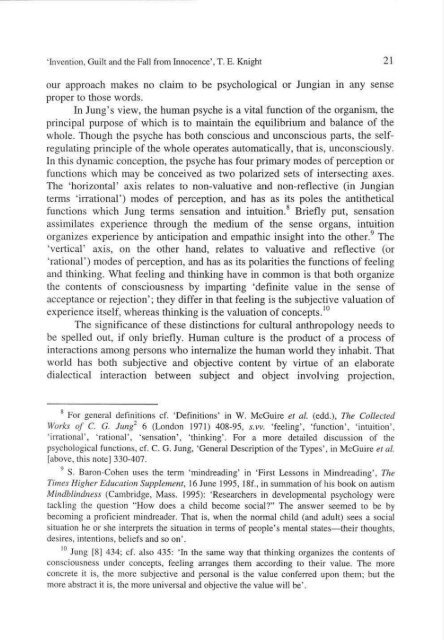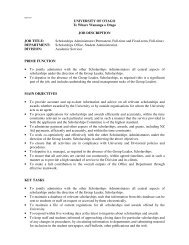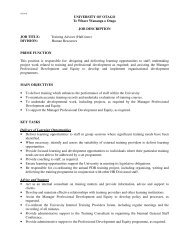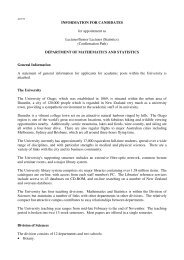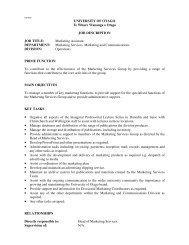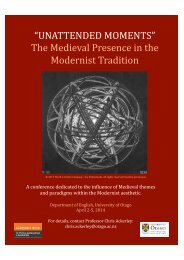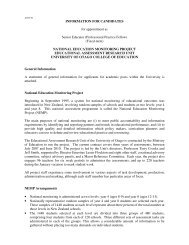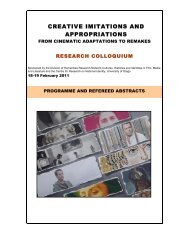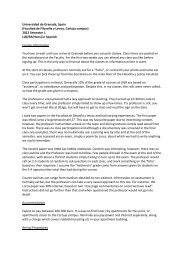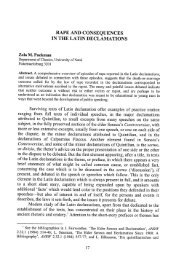scholia - University of Otago
scholia - University of Otago
scholia - University of Otago
Create successful ePaper yourself
Turn your PDF publications into a flip-book with our unique Google optimized e-Paper software.
'Invention, Guilt and the Fall from Innocence', T. E. Knight 21<br />
our approach makes no claim to be psychological or Jungian in any sense<br />
proper to those words.<br />
In Jung's view, the human psyche is a vital function <strong>of</strong> the organism, the<br />
principal purpose <strong>of</strong> which is to maintain the equilibrium and balance <strong>of</strong> the<br />
whole. Though the psyche has both conscious and unconscious parts, the selfregulating<br />
principle <strong>of</strong> the whole operates automatically, that is, unconsciously.<br />
In this dynamic conception, the psyche has four primary modes <strong>of</strong> perception or<br />
functions which may be conceived as two polarized sets <strong>of</strong> intersecting axes.<br />
The 'horizontal' axis relates to non-valuative and non-refle.ctive (in Jungian<br />
terms 'irrational') modes <strong>of</strong> perception, and has as its poles the antithetical<br />
functions which Jung terms sensation and intuition. 8 Briefly put, sensation<br />
assimilates experience through the medium <strong>of</strong> the sense organs, intuition<br />
organizes experience by anticipation and empathic insight into the other. 9 The<br />
'vertical' axis, on the other hand, relates to valuative and reflective (or<br />
' rational') modes <strong>of</strong> perception, and has as its polarities the functions <strong>of</strong> feeling<br />
and thinking. What feeling and thinking have in common is that both organize<br />
the contents <strong>of</strong> consciousness by imparting 'definite value in the sense <strong>of</strong><br />
acceptance or rejection'; they differ in that feeling is the subjective valuation <strong>of</strong><br />
experience itself, whereas thinking is the valuation <strong>of</strong> concepts. 10<br />
The significance <strong>of</strong> these distinctions for cultural anthropology needs to<br />
be spelled out, if only briefly. Human culture is the product <strong>of</strong> a process <strong>of</strong><br />
interactions among persons who internalize the human world they inhabit. That<br />
world has both subjective and objective content by virtue <strong>of</strong> an elaborate<br />
dialectical interaction between subject and object involving projection,<br />
8 For general definitions cf. 'Definitions' in W. McGuire et al. (edd.), The Collected<br />
Works <strong>of</strong> C. G. Junl 6 (London 1971) 408-95, s.vv. 'feeling', 'function', 'intuition'.<br />
'irrational', 'rational', 'sensation', 'tbinldng'. For a more detailed discussion <strong>of</strong> the<br />
psychological functions, cf. C. G. Jung, 'General Description <strong>of</strong> the Types', in McGuire et al.<br />
[above, this note] 330-407.<br />
9 S. Baron-Cohen uses the term 'mindreading' in 'First Lessons in Mindreading', The<br />
Times Higher Education Supplement, 16 June 1995, 18f., in summation <strong>of</strong> h.is book on autism<br />
Mindblindness (Cambridge, Mass. 1995): 'Researchers in developmental psychology were<br />
tackling the question "How does a child become social?" The answer seemed to be by<br />
becoming a pr<strong>of</strong>icient mindreader. That is, when the normal child (and adult) sees a social<br />
situation he or she interprets the situation in terms <strong>of</strong> people's mental states-their thoughts,<br />
desires, intentions, beliefs and so on'.<br />
10 Jung [8] 434; cf. also 435: 'In the same way that th.inking organizes the contents <strong>of</strong><br />
consciousness under concepts, feeling arranges them according to their value. The more<br />
concrete it is, the more subjective and personal is the value conferred upon them; but the<br />
more abstract it is, the more universal and objective the value will be' .


